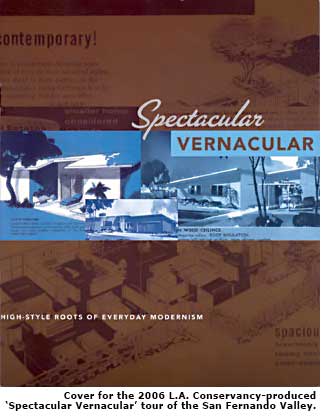Modern Preservation: Streetscape Smarts - Page 4
Architectural overlay zones
The story was quite different in Long Beach, where the city recently passed an ordinance to protect the character of the Cliff May/Chris Choate-designed neighborhood of Rancho Estates. The ordinance blocks second-story additions and demolitions, and will implement design guidelines.
"I think this is a good story of democracy in action," points out Doug Kramer, a resident and real estate broker who handles many sales in the 55-year-old neighborhood.
This was a rare case where the initial idea for protection came not from residents but from the city, Kramer says. Long Beach planners were considering the problem of creeping mansion-ization throughout the town. But the planners didn't quite get what was unique about the simple, board-and-batten, glass-walled ranchos.
"They thought if a second-story addition maintained the same pitch as the original roof and was of board-and-batten siding, it was okay," Kramer says. "I said, no, and educated them about Cliff May's architecture." Neighbors, who had been riled by a recent remodel that "was so hideous and so ill-conceived and such a departure from a Cliff May design," Kramer says, unified behind the proposal. At one meeting, which attracted 200 people who overflowed onto the sidewalk, "all but three raised their hands in support of a restriction on such additions," Kramer says. "This overwhelming support provided critical momentum to our cause."
National and state historic districts
Fans of modern suburbia cheered three years ago, when the 'Historic Quest committee succeeded in placing two Eichler neighborhoods in Palo Alto onto the National Register of Historic Places.
But people considering a similar path for their own neighborhoods need to remember—honor and increased neighborhood pride may be all they get out of it. Despite its prestige, being on the National Register, or on the California Register of Historic Resources, does not confer any added protections.
"It's primarily a program of recognition," says Cynthia Howse, who was with the state Office of Historic Preservation when the Eichlers won their reward. "A certain clout comes with being listed."
The clout comes because people who live in neighborhoods listed on state or national registers can call upon the California Environmental Quality Act (CEQA) for protection if threats loom, arguing that the landmarking shows that their neighborhoods are important cultural resources.
But residents can cite CEQA even if their neighborhoods have only local designation—or even if they have no official designation at all.
Qualifying a neighborhood for the National Register is also a lengthy and involved process. It isn't enough just to be 50 years old. Proponents must complete a rigorous survey of every home in the proposed district to see whether the area is sufficiently intact, and demonstrate, through extensive documentation and photos, why a particular neighborhood is historically significant.
Local historic districts
It is only local historic designation that provides real clout through zoning ordinances and guidelines. But, as proponents point out, local historic districts are only as restrictive as the neighbors want them to be. The guidelines that designations impose are generally developed by neighbors themselves, sometimes in conjunction with consultants. And the architectural committees that enforce those rules are usually made up of members of the neighborhood. In any case, restrictions generally affect only home exteriors—and in many districts, only exteriors that can be viewed from the street.

Forming a historic district takes time, says Ken Bernstein, manager of the Los Angeles Department of City Planning's Office of Historic Resources. Proponents need to build consensus, and conduct a building-by-building survey to determine which homes 'contribute' to the district's historical fabric.
When residents of the 52-home Mar Vista tract sought to become Los Angeles' first modern neighborhood with HPOZ designation in 2003, they won help from the Los Angeles Conservancy, encouragement from the city ("The guy at the city said, 'What took you guys so long?'" HPOZ backer Anni Michaelsen recounts), and, more importantly, the support of 90 percent of their neighbors.
The effort took two years, including a neighborhood petition, a survey, and meetings of the Cultural Heritage Commission, planning commission, and city council. "We attended 28 meetings," Michaelsen remembers. Some people worried that architectural controls would devalue their homes. But proponents argued that the opposite would occur.
"Anecdotal evidence in Los Angeles, and real evidence from elsewhere shows it can increase property values somewhat," says Jay Platt, former advocate with the Los Angeles Conservancy.




